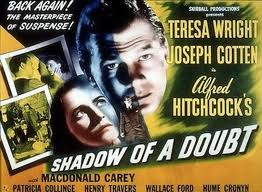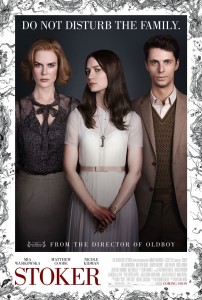DOUBLE FEATURES: Silent Running & Oblivion
Welcome to Double Features, my monthly column dedicated to reviewing a current theatrical release in tandem with a similar classic movie available on DVD. April finds me wondering if Oblivion, Tom Cruise’s new sci-fi effort, shares some DNA with Silent Running, a 1972 cult item that also features a lone astronaut going rogue to protect Earth’s diminishing natural resources from a destructive enemy.
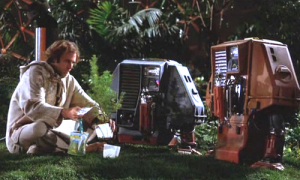
Don’t let the G rating, Joan Baez folk songs, or soft-focus opening shots of bunnies and flowers mislead you. Silent Running – the directorial debut of special effects wiz Douglas Trumbull (2001: A Space Odyssey) – is a somber, adult look at future environmental crisis set entirely aboard a greenhouse space station orbiting a deforested Earth. Bruce Dern goes from docile hippie to psychotic eco-warrior when soulless corporate bosses order him to nuke the last living plant and animal specimens and return to a barren planet sustained by their synthetic amenities. We should be on the oppressed gardener’s side, but his insurrection grows too bloody and paranoid for even the most militant animal activist or macrobiotic foodie to endorse.
Perhaps the only empathetic “characters” in Silent Running are a trio of service robots nicknamed Huey, Dewey, and Louie – reprogrammed to be green-thumbed companions after Dern offs his snide human co-workers. Trumbell’s ingenious miniature droid suits are customized to fit double-amputee actors, who bring a humanizing motion to the walking appliances that’s cute even when they’re digging graves. This is the rare environmental message movie that actually celebrates the machine as nature’s ultimate salvation – a techie’s vision of utopia. It remains progressive today, even if much of the rest of Silent Running suffers from outdated concepts and a meandering plot.

Tom Cruise might hold Bruce Dern’s same custodial occupation on the wasteland of Oblivion, but he’s not going to settle for socializing with a bunch of spherical drones – he wants a hot wife! And not that redheaded nag from his arranged marriage (Andrea Riseborough)… anyone who’s seen Total Recall knows she has ulterior motives for pressing him to spurn Earth for a Saturn moon. No, Cruise dreams of Olga Kurylenko – an enigmatic woman who beckons from repressed memories long before they’re reunited at his secret log cabin tucked inside the last green valley.
The starkest contrast between Silent Running and Oblivion is that Cruise is less preoccupied with rescuing the planet’s ravaged flora and fauna than piecing together his former identity. It’s a self-obsessed journey told largely in cryptic exchanges with coy characters like Morgan Freeman. The mystery unfolds in your head, but never your heart. And once this stooge has finally figured out he’s supposed to be acting like Tom Cruise in a big-budget Hollywood fantasy, many will have grown impatient for some explosions and requisite action.
At best, Silent Running and Oblivion are gentle genre exercises I can only MILDLY RECOMMEND to hardcore science fiction fans thirsting for simple, self-contained stories. Their appeal lies primarily in their visuals. This is a Double Feature that’s easily wiped from the mind, clones of more iconic movies.
April 29, 2013 Posted by Stuart in LA | Movies, Now Playing Podcast, Podcasts, Reviews | bruce dern, double features, oblivion, sci-fi, silent running, tom cruise | 2 Comments
Double Features: Stoker & Shadow Of A Doubt
Welcome to Double Features, my ongoing column devoted to pairing a new theatrical release with a complimentary older title available on home viewing formats.
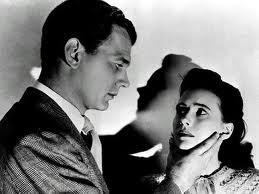 |
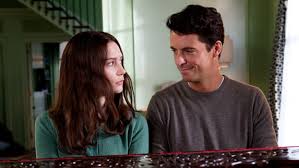 |
| Shadow of a Doubt | Stoker |
For March I’m fixing up stylish new thriller Stoker with 70-year-old Alfred Hitchcock classic Shadow of a Doubt for a double date that explicitly reminds audiences why it’s never a good idea for a girl to lust after her uncle.
Hitchcock movies pack a subversive punch because the director was so clever at sneaking taboo subject matter past his censors. Audiences in 1943 would merely have understood Shadow of A Doubt as the story of a gushing teenager (Teresa Wright) horrified to learn her visiting uncle (Joseph Cotton) is The Merry Widow Murderer. But savvier contemporary viewers will likely be creeped out by the closeness of their familial bond long before Uncle Charlie’s homicidal habits come to light. The nubile niece, also named Charlie, characterizes their connection as “telepathic”, but I’m closer to calling it out as incest.
Shadow of A Doubt isn’t one of Hitchcock’s more suspenseful or technically innovative pictures. The audience spends most of the run time waiting for its naïve star to deduce what they’ve known since the opening scene. But I suspect Hitch called it the favorite work of his career because it does such an expert job satirizing America and traditional Hollywood depictions of wholesomeness. Not only does a niece’s unbridled desire for her uncle go unnoticed in this seemingly upstanding small town, but common folk commiserate over speculation on how they might kill one another, banks profit from blood money, and perversion can be seen beneath the chipped paint of civility in every scene. The one false note of the picture comes when an FBI agent tries to assure the disillusioned young Charlie that people are basically decent and criminals like her uncle are the anomaly.
Stoker clearly invites comparisons to Shadow of A Doubt as it also introduces a homicidal Uncle Charlie (Matthew Goode) into the home of a blossoming schoolgirl (Mia Wasikowska), but takes the scenario one step further by suggesting the two share an inherited proclivity to kill. Dour young India certainly knows her way around a hunting rifle, and thinks nothing of silencing randy classmates with the sharp end of a pencil. But she’s a virgin when it comes to the ways of sex and murder, and spends most of the movie warming up to the idea that her father’s brother (and possible killer) has a lot he could teach her in these areas.
Stoker marks the Hollywood debut of acclaimed director Chan Wook-Park (Oldboy). Like Hitchcock, he’s come to America with a healthy dose of cynicism and an eye for subversive detail. Almost every shot in the picture simmers with Freudian possibilities – from the snaky removal of a belt used to strangle a man during intercourse to a spider crawling up the girl’s thigh as she plays a love song on the piano. These searing images perfectly capture the balance between suppressed desire and sociopathic bloodlust that hangs over our not-so-naïve star’s coming-of-age.
Hitchcock used the incest taboo to tease audiences about presumptions of innocence, but stops far short of nihilism and always delivers crowd-pleasing thrills. Stoker, by contrast, corrupts audiences by asking them to fully explore the darkly erotic possibilities of the uncle-niece union and resists reassurances of societal norms. I RECOMMEND both movies, and suspect viewers will get even more out of seeing them together. But you may not want to invite the family to watch along with you.
March 20, 2013 Posted by Stuart in LA | Movies, Now Playing Podcast, Reviews | double features, hitchcock, Movies, shadow of a doubt, stoker | Comments Off on Double Features: Stoker & Shadow Of A Doubt
-
Archives
- February 2021 (1)
- January 2021 (1)
- December 2020 (1)
- November 2020 (3)
- October 2020 (2)
- September 2020 (1)
- August 2020 (2)
- July 2020 (1)
- June 2020 (1)
- May 2020 (1)
- April 2020 (3)
- March 2020 (2)
-
Categories
-
RSS
Entries RSS
Comments RSS
Site info
Venganza Media GazetteTheme: Andreas04 by Andreas Viklund. Get a free blog at WordPress.com.
